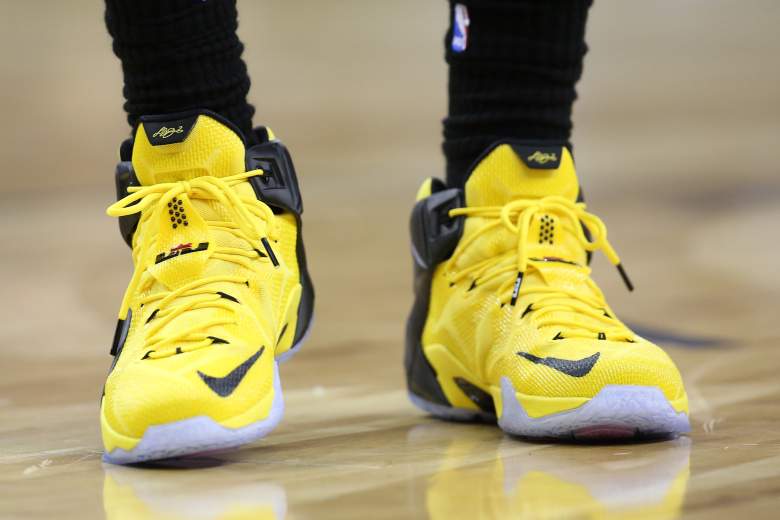
LeBron James sports a pair of yellow Nike basketball shoes in a December 2014 game against the New Orleans Pelicans. (Getty)
As thoughts turn to working off the festive excesses in January, a new pair of running shoes is at the top of many shopping lists. But, as new thinking about footwear gathers pace, are the famous swoosh and the other established brands still the first choices for runners?
Nike & the Rise of the Modern Running Shoe
The giant of sportswear retail, Nike has certainly started 2015 in confident mood: revenue grew 10 percent to $27.8 billion in 2014.
Among its plans for this year is the re-release of its MAG shoes, with futuristic self-tightening laces that that will delight fans of the 1989 film Back to the Future Part II, where they were worn by Michael J. Fox as Marty McFly.
Walk into any running shop and you’ll see an array of Nike trainers for sale, along with Asics, Reebok, Adidas, Mizuno, Saucony and more. They all come in a bewildering variety of styles, described as offering different benefits. However, they do share certain common features: a thick, cushioned sole; rigid support for the arch of the foot and a slightly raised heel compared to the toe.
Nike is credited with initiating this design, typically seen in modern running shoes, which evolved from its original waffle-tread trainers launched in 1972. The company’s co-founder, University of Oregon track coach Bill Bowerman, invented the shoe’s springy rubber soles using an ancient family waffle iron, and they pleased elite athletes and amateur runners alike. Time magazine wrote at the time that the shoe was “grabbed by the army of weekend jocks suffering from bruised feet.” It was enough to start Nike’s rise from a small company selling shoes from a car boot at race venues to a multi-billion dollar global titan.
Over the years, running footwear manufacturers developed more and more technical features, primarily to address runners’ perennial worry: the risk of injury. Gel pods, air pockets or coiled springs were incorporated to cushion impact with the ground, heels were raised and soles were constructed to support the foot and control its movement. It became received wisdom among runners that a good pair of shoes from a major brand was essential if you wanted to run without getting hurt. The Runner’s World website still gives this advice for beginners, “Resist the lure of the old trainers languishing in your wardrobe … Worn-out or ill-fitting shoes are a recipe for injury. Go to a specialist running shop to get a pair with the fit and support you need.”
Revolution Afoot
But in 2009, voices of dissent against this view began to be heard. Christopher McDougall’s book, Born to Run, was to become a global best-seller, and in it he challenges the major running footwear brands to produce any scientific proof that their shoes assist in injury prevention. McDougall tells the story of his own injury-prone history as a runner, buying ever-more-expensive trainers to no avail. His quest for a different solution takes him to meet Mexico’s reclusive Tarahumara tribe, who routinely run immense distances over mountain terrain – usually barefoot or wearing simple sandals (“huaraches”) made from old tyres. By learning to run barefoot, McDougall finds that he too can tackle ultra-distances without injury.
The message from Born to Run is that humans evolved as natural runners, and that the prevalence of injuries in the sport is a modern phenomenon. ‘Antelope don’t get shin splints. Wolves don’t ice-pack their knees. I doubt that 80% of all wild mustangs are annually disabled with impact injuries,’ says McDougall. His controversial suggestion is that shoes are unnecessary – and may even be damaging – for a runner. And his view has gained traction with a small but significant – and growing – section of the running community.
It also has scientific support. Harvard anthropologist Dr Daniel Lieberman, for example, is known as ‘the barefoot professor’. His studies have demonstrated that landing on the front part of the foot, as barefoot runners naturally tend to, creates lower impact forces than landing on the heel. According to Lieberman’s website, “runners who forefoot or midfoot strike do not need shoes with elevated cushioned heels to cope with these sudden, high transient forces.”
Barefoot Brands Stride Forward
But while runners are embracing the “barefoot” school of thought, running unshod does pose practical problems — hence the entrance of a number of “minimalist” running shoe and sandal brands. Their products all feature thin, flexible soles without cushioning or support, have no heel elevation, and aim to mimic the barefoot running experience while protecting feet from broken glass and other hazards. Chief among them is Italian firm Vibram, maker of the quirky ‘FiveFingers’ shoes with individual toe compartments. Vivobarefoot, Merrell, New Balance, Xero Shoes, Luna Sandals and others have also found favour with runners.
It hasn’t been an entirely easy journey for Vibram, which was hit by a lawsuit recently. Disgruntled customer Valerie Bezdek claimed that Vibram had, without any scientific proof, implied its shoes could reduce foot injuries and strengthen foot muscles. The company settled the claim, without admitting liability, last year. And despite having to set aside $3.75 million for subsequent claims, Vibram seems to have benefitted overall. In a Huffington Post article, US CEO Mike Gionfriddo said ‘Between 2013 and 2014 our business has been pretty stable. In May, when we settled the lawsuit, we had an increase of about 17 percent in new [retailers] and retail distribution of our products, so that’s pretty promising for us for the future.”
So where does all this leave our established giants of the running footwear industry? Well, for now the minimalist shoe brands remain relatively small and lack the marketing budgets of their larger rivals. And their products also come with a slightly disconcerting health warning: runners accustomed to the support of modern shoes are advised to give their muscles time to adapt to the ‘barefoot’ running style or risk pain and even injury.
Nevertheless, the threat is on Nike’s radar, and it has responded by developing a product of its own, the Nike Free trainer. Although not a fully minimalist shoe, having a slightly raised heel and a thicker sole, it has attracted many runners who are intrigued by barefoot running but prefer to stick with a familiar brand. Nike has also created a shoe called the Huarache, although this has drawn scorn from minimalist aficionados as it’s heavily cushioned and bears no resemblance to a tribal running sandal.
So it seems that Nike is both poised and well-equipped to react, if the minimalist shoe market continues to grow. However, the subversive message from the barefoot running community remains that major brands may be selling us products that are unnecessary, unnatural or even harmful. This could undermine trust and ultimately hurt profits for the big running footwear suppliers.

Comments
After Impressive 2014, Can Nike Keep Up With Trends in Footwear?